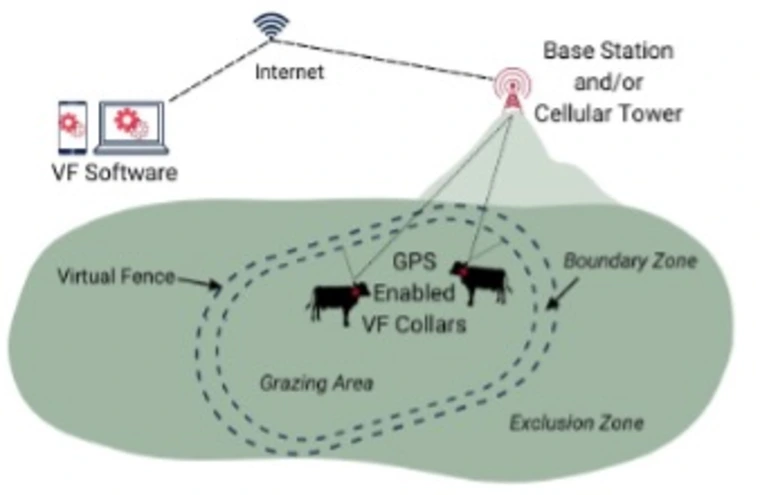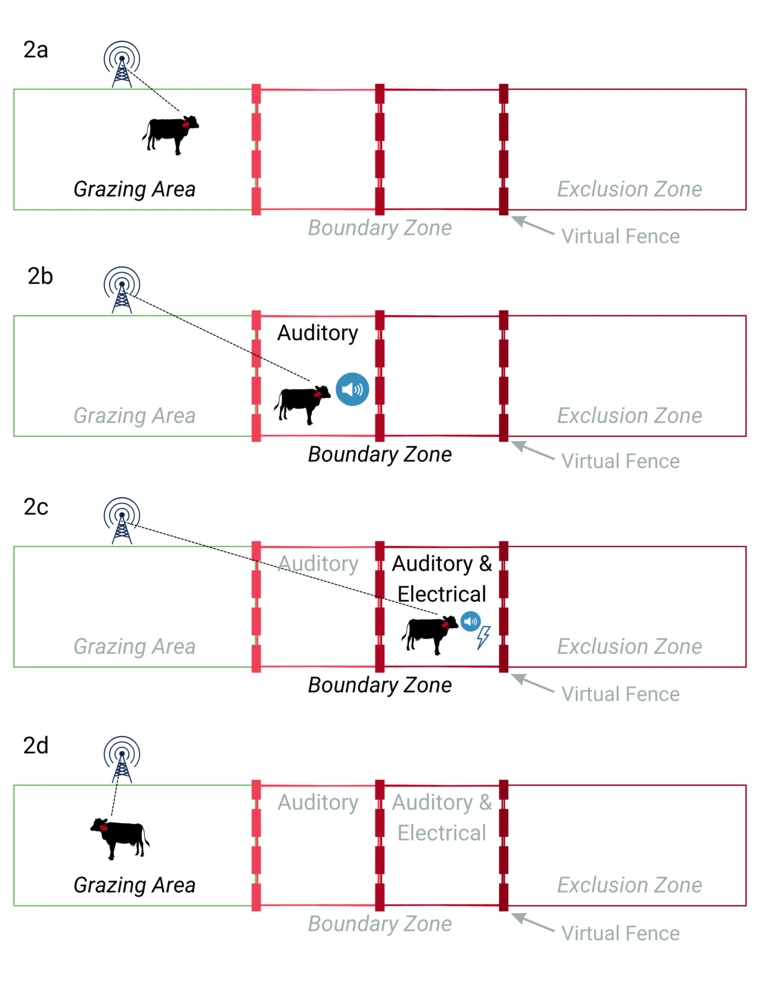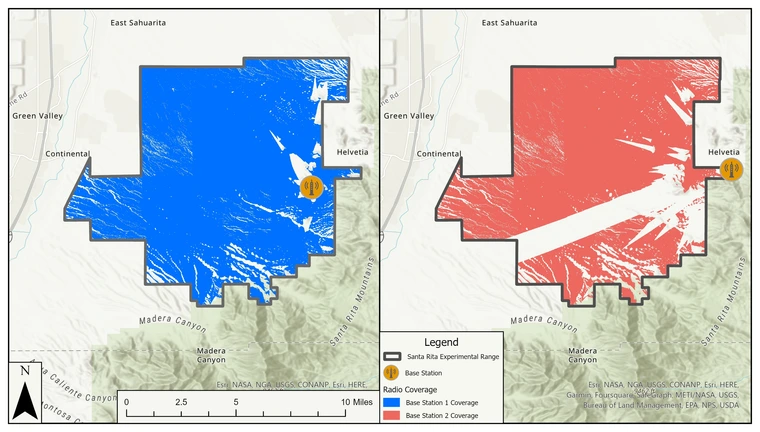Background
In Arizona and other western states, ranchers and land managers rely on thousands of miles of permanent wire fencing to manage livestock on rangelands. Patented in 1874, this type of fencing has been widely used to control the timing and distribution of livestock grazing across the landscape (Ray and Schamel 1997). When combined with modern rangeland management principles, the use of wire fencing has led to improved rangeland condition in many places by aiding in the application of grazing systems (Holecheck et al. 2011). However, permanent fencing also results in significant management limitations. Wire fencing can fragment landscape connectivity, pose a risk to wildlife, and can be a major financial investment for ranchers and land management agencies to establish and maintain (Jakes et al. 2018). Additionally, permanent fences provide little to no flexibility to rapidly change pasture size, manipulate grazing distribution, or avoid areas of high use or sensitive habitat within a pasture. As a result, there are constraints on the use of permanent fences as a tool for managing riparian health, post-fire vegetation recovery, or improving livestock distribution. Precision livestock management technologies have emerged in recent years to address these limitations and increase management flexibility and adaptive capacity to respond to changing environmental conditions as part of a larger grazing management system that balances economic and ecological outcomes (Trotter 2010; di Virgilio et al. 2018; Lima et al. 2018). Virtual fencing is one such technology.
Components of Virtual Fencing
Virtual fencing (VF) is a management tool that uses invisible barriers, established using Global Positioning System (GPS) coordinates, that influence livestock movement with a combination of auditory and electrical cues. The primary elements of a VF system are a software interface, collars worn by livestock, and a radio or cellular-based system that allows the software and collars to communicate (Figure 1).
A smartphone, tablet, or computer software interface is used to digitally draw virtual fence lines on an image of the landscape using satellite imagery or a topographic map. Each virtual fence drawn includes a boundary zone: a defined amount of space that extends out from where the virtual fence line is drawn on the map and acts as a buffer to alert livestock when they are approaching a virtual fence. Just like with a traditional wire fence, the area enclosed by the virtual fence boundary is the grazing area and is intended for use by livestock. The area outside the virtual fence boundary which is not intended for use by livestock is the exclusion zone. Using the VF software, users may remotely activate or deactivate virtual fences according to a predetermined schedule or as needed. It takes approximately ten minutes to create a virtual fence.
Virtual fence collars are electronic devices fitted around the circumference of an animals’ neck. Collars contain technology for transmitting and receiving GPS and radio or cellular signals to track livestock movement and position relative to virtual fences. Depending on the manufacturer, collars are powered by batteries that are either non-rechargeable and must be changed, or are solar rechargeable. Each collar’s on-board GPS determines the animal’s location in relation to the boundary zone (Figure 2a). Virtual fencing uses negative reinforcement to build, modify, and maintain an association between the auditory cue and electrical cue. For more information, see Rangelands Gateway (https://rangelandsgateway.org/virtual-fence).
When animals are within the grazing area, no auditory or electrical cues are activated. When an animal enters the boundary zone, the collar first emits an auditory cue, or a high-pitched beeping sound that warns the animal of virtual fence proximity (Figure 2b). If the animal continues through the boundary zone, the collar will emit both an auditory cue and an electrical cue, or slight electrical pulse (Figure 2c). In most cases, the animal will turn around and exit the boundary zone in response to cues (Figure 2d). Both cues stop if the animal enters the exclusion zone. When an animal breaches a virtual fence into the exclusion zone, the virtual fence acts as a “one-way gate” where the animal can return into the grazing area without receiving auditory or electrical cues, but will receive auditory and electrical cues if it attempts to leave the virtual fence again. Over a training period specified by the manufacturer, livestock will learn to associate the auditory cue with the electrical cue and generally stay within the confines of the grazing area in response to only the auditory cue. In some cases, individuals may respond differently to the auditory and electrical cues and may develop strategies for pushing through the virtual fence. To reduce the impacts of stress on the animals, this association should be predictable and controllable to livestock. For more information on the effects of auditory and electrical cues on livestock, see Mayer et al. (in review).
The VF software communicates boundary zone information to collars. Depending on the manufacturer, data is transmitted and received via cellular towers or solar-powered base stations, which are physical structures on the landscape that act as a transmitter and receiver using radio, cellular networks, and/or satellites. There is a lag between when a virtual fence is programmed in the software and when the collars receive the programming. The programming generally takes between one hour and up to three days, but the exact timing is dependent on the size of the herd, location of a specific animal, and landscape topography. All collars must be within range of the cellular tower or base station to receive the updated programming. If a collar is out of range, the updated programming will not be issued until the animal moves back within range. Therefore, virtual fences cannot be activated or deactivated instantaneously to immediately manage livestock.
A base station is ideally placed in a location where there is both reliable cellular service and where it can provide the maximum amount of VF coverage to ensure communication between the software and the collars. Multiple base stations may be needed to provide adequate coverage. Base station coverage varies widely depending on terrain and typically covers more area if the base station is located at a higher elevation than the pasture or allotment. If the base station is positioned without considering the landscape topography, the coverage can be impacted by a mountain or other elevation change and may result in no signal on the far side of a peak or depression (Figure 3). Base station coverage maps are an essential tool for successful implementation of a VF system. Coverage maps can be developed in conjunction with a VF manufacturer or with an ESRI ArcGIS Pro tool developed by the University of Arizona (McMullen and Antaya 2023).

Figure 1: Conceptual model of virtual fencing (VF) hardware and software used to establish and adjust a virtual fence and the boundary zone.

Figure 2: Conceptual model of livestock interactions with a virtual fence boundary zone.

Figure 3. Two base station coverage maps showing differences in coverage depending on the position of the base station relative to topography at the Santa Rita Experimental Range (SRER).
A future without fences?
As an emerging precision livestock management technology, VF systems have not been rigorously tested in a wide variety of ecosystems. Virtual fencing has been largely successful at controlling livestock movement and limiting the use of burned areas in a flat sagebrush plant community outside of Burns, Oregon (Boyd et al. 2022). While promising, this study recognized the need to evaluate VF at larger spatial scales and in more topographically complex environments to better understand the effectiveness of VF systems in rangeland cattle production systems (Boyd et al. 2022). Preliminary results from the University of Arizona at the Santa Rita Experimental Range (SRER) in southern Arizona show that VF can be used to restrict the distribution of cattle within a pasture and reduce grazing activity in a riparian area, while encouraging grazing activity in a historically less used portion of the pasture. Preliminary observations on the SRER indicate the same individuals routinely pushed through the virtual fence, suggesting that there may be individual animals that don’t respond to virtual fence cues, and may be difficult to manage with virtual fences. Virtual fencing holds the potential to revolutionize grazing management in Arizona and the western United States by controlling the distribution, timing, and duration of livestock grazing on rangelands (Anderson et al. 2014). Implementing virtual fence systems, however, may be challenging due to the high upfront costs, and the logistical considerations of changing batteries and locating lost collars if they fall off animals. This tool may allow producers to design grazing systems that maximize quality forage intake, while more evenly distributing grazing across an area, and may potentially lower costs associated with maintenance of physical fences. However, it is unknown if virtual fences are an economically viable tool for producers. A more detailed cost comparison between wire fences and virtual fences will be made in a future article. Virtual fences may increase management flexibility by providing the ability to rapidly change grazing patterns, which may have implications for animal management and welfare, sustainability, economics, adaptive management, and rangeland ecology. Before adopting virtual fence systems, consider the tradeoffs between permanent wire fences and virtual fences. Wire fences may entrap animals, can be easily damaged by fire or vandalism, require periodic maintenance, and are less flexible as a management tool. Virtual fence has high upfront cost, and likely does not work for all ranches or for all individuals in a herd, but are more flexible as a management tool. Some animals may develop strategies for pushing through the virtual fence. While physical fencing is still needed today, VF as a precision livestock management technology may help reduce the reliance on permanent wire fences while increasing management flexibility to respond to a changing landscape.
Disclaimer
There are several companies that manufacture hardware and software for commercial use including Corral Technologies™, eShepherd™, NoFence™, and Vence™. Virtual fencing components from different manufacturers are generally not interoperable or interchangeable. Specific components, GIS data needs, software protocol, software training, frequency and duration of the cues, GPS error, livestock collaring, and livestock training protocols may vary depending on the manufacturer. Follow the manufacturer’s recommendations and guidelines. The University of Arizona does not endorse a specific product.
Acknowledgements
This material is based upon work that is supported by the National Institute of Food and Agriculture, U.S. Department of Agriculture, under award number 2021-38640-34695 through the Western Sustainable Agriculture Research and Education program under project number WPDP22-016. USDA is an equal opportunity employer and service provider. Any opinions, findings, conclusions, or recommendations expressed in this publication are those of the author(s) and do not necessarily reflect the view of the U.S. Department of Agriculture.
This work is supported by the AFRI Foundational and Applied Science Program: Inter-Disciplinary Engagement in Animal Systems (IDEAS) [award no. 2022-10726] from the USDA National Institute of Food and Agriculture.
Additional funding for the University of Arizona’s Virtual Fence program was provided by Arizona Experiment Station, the Marley Endowment for Sustainable Rangeland Stewardship, and Arizona Cooperative Extension.
For additional information about virtual fencing, visit: https://rangelandsgateway.org/virtual-fence
References
G. B. Smith. 2014. Virtual herding for flexible livestock management – a review. The Rangeland Journal 36:205–221.
Boyd, C. S., R. O’Connor, J. Ranches, D. W. Bohnert, J. D. Bates, D. D. Johnson, K. W. Davies, T. Parker, K. E. Doherty. 2022. Virtual Fencing Effectively Excludes Cattle from Burned Sagebrush Steppe. Rangeland Ecology & Management 81: 55-62.
di Virgilio, A., J. M. Morales, S. A. Lambertucci, E. L. C. Shepard, and R. P. Wilson. 2018. Multi-dimensional Precision Livestock Farming: a potential toolbox for sustainable rangeland management. PeerJ 6:e4867. doi:10.7717/peerj.4867
Holechek, J. L., R. D. Pieper, and C. H. Herbel. 2011. Range Management: Principles and Practices. 6th edition. Prentice Hall, Upper Saddle River, New Jersey.
Jakes, A. F., P. F. Jones, L. C. Paige, R. G. Seidler, M. P. Huijser. 2018. A fence runs through it: A call for greater attention to the influence of fences on wildlife and ecosystems. Biological Conservation 227: 310-318.
Lima, E., T. Hopkins, E. Gurney, O. Shortall, F. Lovatt, P. Davies, G. Williamson, and J. Kaler. 2018. Drivers for precision livestock technology adoption: A study of factors associated with adoption of electronic identification technology by commercial sheep farmers in England and Wales. PLOS ONE 13:e0190489.
Mayer, B., A. Dalke, A. Antaya, J. Beard, S. Noelle, and A. Lien. In Review. Livestock and virtual fencing: Foundations of conditioning for animal welfare. University of Arizona Extension Publication.
McMullen, L. and A. Antaya. 2023. lilymcmullen/OptimalVisibilityTool: Alpha Release. https://doi.org/10.5281/ZENODO.8118534
Ray, E., and W. Schamel. 1997. Glidden’s patent application for barbed wire. Social Education 61:53–56.
Trotter, M. 2010. Precision agriculture for pasture, rangeland and livestock systems. Pages 1–6 in. Food Security from Sustainable Agriculture: Proceedings of the 15th Australian Agronomy Conference. Australian Society of Agronomy Inc, Lincoln, New Zealand. <https://rune.une.edu.au/web/handle/1959.11/7894>. Accessed 23 Aug 2023.

